Why It’s Too Late To Contain COVID-19
by Emad Mostaque via LinkedIn.com,
ZeroHedge.com
Thu, 02/13/2020
While we may have reservations about Chinese data, there is no doubting they have done a sterling job in trying to contain the COVID-19 outbreak (as the new coronavirus symptoms are now known). However, it is not enough and we have now reached a point where it is impossible to contain. This piece looks at why.
Diseases such as SARS and Ebola have high spreadability and high mortality, but thankfully we managed to keep them both under control through aggressive containment policies.
China effectively shutting down its cities and adopting aggressive containment processes at a level never seen before has helped slow down the spread of COVID-19, but unfortunately it may now be too late as additional clusters appear around the world.
The infectivity rate, R0, is how many people one infected individual infects on average, for a given population. Factors such as herd immunity, climate etc can affect this, but so far we see around 2.5 people per infected person which means it spreads aggressively. We are perhaps also seeing evidence of superspreaders like SARS. For reasons we do not fully understand, most SARS carriers did not get other people sick. Some infected 50 or more.

Aside from concerns over severe cases flooding ICUs, with a higher apparent severity case than most, the main factor that is concerning about COVID-19 has been the long incubation period and asymptomatic transmission through proximity alone, something we haven’t really seen before.
This makes it so hard to detect, as opposed to SARS and Ebola, as well as other highly infectious diseases such as measles. Combined with relatively inaccurate tests which are not widely distributed, for example only to two African countries and just now to Indonesia, it is reasonable to expect that the disease has spread and is incubating in clusters all over the world, particularly as the symptoms are so similar to the normal flu. It being flu season when would you even come in for testing? Flu is still deadly, with more people dying of flu in China since the start of the crisis than from COVID-19.
Here is where it gets really interesting. As discussed in my previous article, the precautionary principle means we will keep our kids out of school and change our behaviour in developed society until this blows over and we get more data, just in case.
In low and middle income societies with poorer hygiene and high population density, like much of Africa and Asia, this won’t be the case.
It’s impossible to quarantine and even test everyone, so disease will continue to spread and most deaths, which will hopefully be low, will be outside of the hospital system, which is already stretched.
This means even if developed nations shut their borders and flights for a period, secondary waves originating in these low and middle income countries may continue to come for many months, leading to new cluster, particularly as the vast majority only get mild symptoms if any at all.
LMIC governments have no option but to get on with things and do the best they can from a top down basis as they couldn’t shut down and quarantine even if they wanted to with so many lacking a buffer in their countries.
This means the economic impact is likely to be larger in developed markets initially, with the main impact on LMICs being secondary demand destruction as opposed to the local economy grinding to a halt.
We cannot even expect for herd immunity to be the answer given the high mutability of the coronavirus from initial data, with the potential for some people to be infected twice and some cases occurring 24 days after an all clear on unreliable tests. Even if a vaccine is created, the flu vaccine can have effectiveness as low as 30% for certain populations.
There have been some arguments heat may denature or reduce the spread, which may be the case. For middle and high income countries that rely on air conditioning, this may unfortunately make things worse, as we have seen with the sharp rise in Singaporean cases where the temperature is 90° F and 15% of the 50 confirmed cases are already in the ICU. Even with SARS we saw a secondary wave in the heat.
In conclusion, the likely secondary incubation points and limited policy response of LMICs means we should expect waves of coronavirus and focus not on shutting our borders and damaging global trade, but on bulking our treatment and care responses.
In particular interventions that stop cytokine storm collapses and increased respiration and oxygen response for standard complications should be accelerated even at this stage with new facilities created to produce these and new interventions tested.
We remain in hope this will resolve itself quickly, but we need to be prepared for the long haul.

